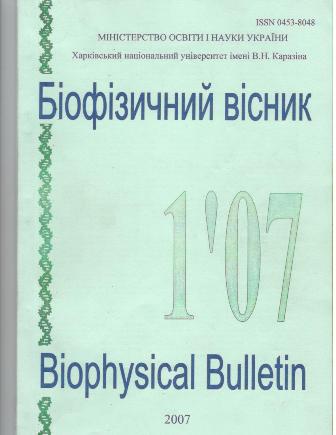Морфологічна реакція еритроцитів на зміну електролітного складу середовища. II. Вплив інгібіторів аніонного транспорту
Анотація
Вивчено вплив інгібіторів аніонного транспорту еритроцитів DIDS, SITS і DNDS на динаміку зміни їх форми в неелектролітних сахарозних середовищах з низьким вмістом іонів хлору. Встановлено, що характер дії DIDS і SITS однаковий, але для SITS діюча концентрація, яка призводить до того ж ефекту в кілька разів меньш ніж для DIDS. Обидві речовини концентраційно залежним чином впливають на характерну трифазну послідовність змін форми еритроцитів послідовно елімінуючи третю і другу фазу перетворень і, в кінцевому рахунку, стабілізують першу сфероподібну фазу, що характеризується низьким значенням індексу форми (ІФ), яке клітини набувають відразу після приміщення їх в неелектролітну середу , що містить інгібітори. Мікроскопічний аналіз показує, що ця фаза представлена, в основному, сферостоматоцитами. Якщо ту ж кількість інгібіторів додавали в середу через 150 с після клітин, то це, навпаки, призводило до збільшення ІФ, що свідчить про уплощення еритроцитів. Дія DNDS істотно відрізнялося від DIDS і SITS в тому відношенні, що він не впливав на форму еритроцитів, якщо додавався до них через 150 с після того як клітини були поміщені в середу сахарози. Якщо DNDS був присутній в середовищі спочатку, то всі фази морфологічних змін зберігалися, але час кожної з фаз зростал при збільшенні концентрації інгібітору. Отримані дані показують, що морфологічні перетворення клітин в неелектролітних середовищах, істотно залежать не тільки від стану системи аніонного транспорту еритроцитів, але і від конкретної хімічної природи інгібітору.
Завантаження
Посилання
Bennekou P, Barksman n TL, Kristensen BI, Jensen LR, Christophersen P. Pharmacology of the human red cell voltage-dependent cation channel. Part II : inactivation and blocking. Blood Cells Mol.Dis. 2004:33(3):356-61.
Glaser R. Does the transmembrane potential (Deltapsi) or the intracellular pH (pHi) control the shape of human erythrocytes?. Biophys.J. 1998;75(1):569-70.
Muller P, Herrmann A, Glaser R. Further evidence for a membrane potential-dependent shape transformation of the human erythrocyte membrane. Biosci.Rep. 1986:6(11):999-1006.
Hartmann J, Glaser R. The influence of chlorpromazine on the potential-induced shape change of human erythrocyte. Biosci.Rep. 1991;11(4):213-21.
Sambasivarao D, Rao NM, Sitaramam V. Anomalous permeability and stability characteristics of erythrocytes in non-electrolyte media. Biochim.Biophys.Acta. 1986;857(1):48-60.
Betz T, Bakowsky U, Muller MR, Lehr CM, Bernhardt I. Conformational change of membrane proteins leads to shape changes of red blood cells. Bioelectrochemistry. 2007;70:122-126.
Kaestner L, Christophersen P, Bernhardt I, Bennekou P. The non-selective voltage-activated cation channel in the human red blood cell membrane: reconciliation between two conflicting reports and further characterisation. Bioelectrochemistry. 2000;52(2):117-25.
Barksmann TL, Kristensen BI, Christophersen P, Bennekou P. Pharmacology of the human red cell voltage- dependent cation channel; Part I. Activation by clotrimazole and analogues. Blood Cells Mol.Dis. 2004;32(3):384-8.
Bennekou P, Kristensen BI, Christophersen P. The human red cell voltage-regulated cation channel. The interplay with the chloride conductance, the Ca(2+)-activated K(+) channel and the Ca(2+) pump J.Membr.Biol. 2003;195(1):1-8.
Blank ME, Hoefner DM, Diedrich DF. Morphology and volume alterations of human erythrocytes caused by the anion trasporter inhibitors, DIDS and p-azidobenzylphlorizin. Biochim.Biophys.Acta. 1994;1192(2):223-33.
Wong P. Mechanism of control of erythrocyte shape: a possible relationship to band 3. J.TheorBiol. 1994;171(2):197-205
Gimsa J. A possible molecular mechanism governing human erythrocyte shape Biophys.J 1998;75(1):568-9.
Sheetz MP, Alhanaty E. Bilayer sensor model of erythrocyte shape control. Ann.N.Y.Acad.Sci. 1983;416:58-65.
Jones GS, Knauf PA. Mechanism of the increase in cation permeability of human erythrocytes in low-chloride media. Involvement of the anion transport protein capnophorin. J.Gen.Physiol 1985:86(5):721-38.
Zeidler RB, Kim HD. Effects of low electrolyte media on salt loss and hemolysis of mammalian red blood cells. J. Cell Physiol. 1979;100(3):551-61.
Kummerow D, Hamann J, Browning JA, Wilkins R, Ellory JC, Bernhardt I. Variations of intracellular pH in human erythrocytes via K(+)(Na(+))/H(+)exchange under low ionic strength conditions. J.Membr.Biol. 2000;176(3):207-16.
Rudenko SV, Krouf DzhKh, Tablin F. Izmenenie formy eritrotcitov v zavisimosti ot vremeni. Biokhimiia. 1998;63(12):46-55. (in Russian)
Rudenko SV. Agregatciia eritrotcitov kak model agregatci trombotcitov. Biologicheskie membrany. 2006;23(1):61-8. (in Russian)
Eriksson LE. On the shape of human red blood cells interacting with flat artificial surfaces—the ‘glass effect’. Biochim.Biophys.Acta. 1990;1036(3):193-201.
Tachev KD, Danov KD, Kralchevsky PA. On the mechanism of stomatocyte-echinocyte transformations of red blood cells: experiment and theoretical model. Colloids. Surf.B.Biointerfaces. 2004;34(2):123-40.
Svetina S, Kuzman D, Waugh RE, Ziherl P, Zeks B. The cooperative role of membrane skeleton and bilayer in the mechanical behavior of red blood cells. Bioelectrochemistry. 2004;62(2):107-13.
Deuticke B. Transformation and restoration of biconcave shape of human erythrocytes induced by amphiphilic agents and changes of ionic environment. Biochim. Biophys. Acta. 1968;163:494-500.
Schwarz S, Haest CW, Deuticke B. Extensive electroporation abolishes experimentally induced shape transformations of erythrocytes: a consequence of phospholipid symmetrization? Biochim. Biophys. Acta. 1999:1421(2):361-79.
Reinhart WH, Chien S. Echinocyte-stomatocyte transformation and shape control of human red blood cells: morphological aspects. Am.J.Hematol. 1987:24(1):1-14.
Nwafor A. Coakley WT. Charge-independent effects of drugs on erythrocyte morphology. Biochem. Pharmacol. 1985;35(6):953-7.
Nwafor A, Coakley WT. Drug-induced shape change in erythrocytes correlates with membrane potential change and is independent of glycocalyx charge. Biochem.Pharmacol. 1985:34(18):3329-36.
Chen JY, Huestis WH. Role of membrane lipid distribution in chlorpromazine-induced shape change of human erythrocytes. Biochim.Biophys.Acta. 1997,1323(2)299-309.
Автори, які публікуються у цьому журналі, погоджуються з наступними умовами:
- Автори залишають за собою право на авторство своєї роботи та передають журналу право першої публікації цієї роботи на умовах ліцензії Creative Commons Attribution License, котра дозволяє іншим особам вільно розповсюджувати опубліковану роботу з обов'язковим посиланням на авторів оригінальної роботи та першу публікацію роботи у цьому журналі.
- Автори мають право укладати самостійні додаткові угоди щодо неексклюзивного розповсюдження роботи у тому вигляді, в якому вона була опублікована цим журналом (наприклад, розміщувати роботу в електронному сховищі установи або публікувати у складі монографії), за умови збереження посилання на першу публікацію роботи у цьому журналі.
- Політика журналу дозволяє і заохочує розміщення авторами в мережі Інтернет (наприклад, у сховищах установ або на особистих веб-сайтах) рукопису роботи, як до подання цього рукопису до редакції, так і під час його редакційного опрацювання, оскільки це сприяє виникненню продуктивної наукової дискусії та позитивно позначається на оперативності та динаміці цитування опублікованої роботи (див. The Effect of Open Access).




